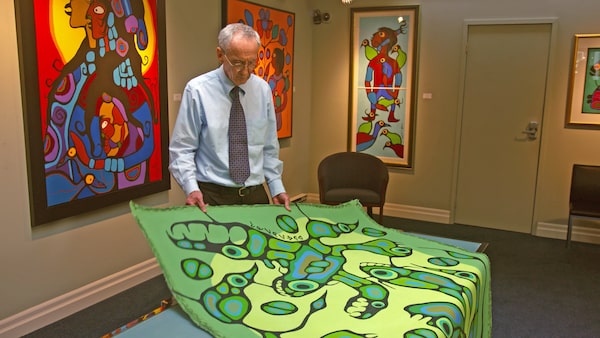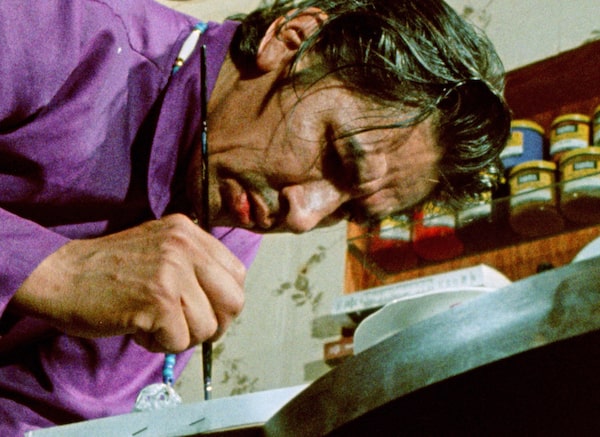Barenaked Ladies keyboardist Kevin Hearn has been kicking at one particular corner of Canadian darkness for almost a decade now, ever since he discovered that a prized painting he bought was probably a forgery.David Leyes/Courtesy of Cave 7 Productions Inc.
Barenaked Ladies keyboardist Kevin Hearn likes to quote a line from the Bruce Cockburn song Lovers in a Dangerous Time: “Got to kick at the darkness 'til it bleeds daylight.” Hearn has been kicking at one particular corner of Canadian darkness for almost a decade now, ever since he discovered that a prized painting he bought was probably a forgery.
The painting was supposedly the work of renowned Ojibwe artist Norval Morrisseau, who died in 2007, but experts disagreed. Many collectors are too embarrassed to complain when they believe they have been defrauded, but Hearn refuses to be silent. First, he took an art dealer to court; now, he has participated in a documentary, There Are No Fakes, that exposes a Thunder Bay, Ont., ring that produced fake Morrisseaus. Working with filmmaker Jamie Kastner, Hearn found his dubious Morrisseau took them deeper and deeper into an ugly story.
Films opening this week: The unstoppable Avengers: Endgame, plus Toronto’s Hot Docs festival begins
“Initially it was out of indignation – I had been ripped off,” Heard said in a recent interview. But then “I started sensing there was a far greater injustice here. People had been hurt, people had been exploited.”
There Are No Fakes uncovers the destruction of a famous artist’s legacy – and the horrible damage to several less-famous lives.

In 2010, Hearn included the painting in an Art Gallery of Ontario exhibition that he was curating – until professional curators informed him it wasn’t Morrisseau’s work.Cave 7 Productions Inc.
Hearn’s connection began in 2005 when he bought a large green painting that had what appeared to be Morrisseau’s signature on the back at a Toronto gallery. In 2010, he included it in an Art Gallery of Ontario exhibition that he was celebrity curating – until professional curators sadly informed him it wasn’t Morrisseau’s work. Hearn went back to the dealer, Joseph McLeod (who has since died), and asked for his money back. McLeod responded that a refund would be an admission of guilt.
Many collectors might have just walked away sadder and wiser. Admitting you’ve acquired a fake doesn’t make you look like a discerning buyer. But Hearn was so angered that he decided to sue. Ultimately, a judge ruled last year that while his lawyer had proved the existence of a forgery ring, there was no way to determine that it had produced Hearn’s painting – and, in law, the benefit of the doubt goes to the defence. Hearn is appealing that ruling, but it has become clear that, when it comes to venality, fake paintings are only the tip of the iceberg.
“Even though I was hearing it from someone I knew to be trustworthy, I couldn’t believe it,” Kastner said of the case. “It was only when I started to research and dug into the characters that I realized it was real.”
Jamie Kastner, director of There Are No Fakes, played in a band with Hearn in high school and initially got back in touch by suggesting the musician collaborate on a posthumous biography of American singer Lou Reed, whom Hearn knew. Instead, Hearn offered Kastner the Morrisseau story.david leyes/Courtesy of Cave 7 Productions Inc.
Kastner, a Toronto documentarian, played in a band with Hearn in high school and initially got back in touch by suggesting the musician collaborate on a posthumous biography of American singer Lou Reed, whom Hearn knew. Instead, Hearn offered Kastner the Morrisseau story.
“I saw it as a sign: The universe sent me Jamie,” Hearn said of his decision to try fighting through film.
Kastner agreed to the project, but warned Hearn that it would be a journalistic documentary and the musician would have no creative control. Dealers and collectors who defend their paintings as legitimate Morrisseaus, and argue that allegations of fraud are just an attempt by a few dealers to corner the market, would get a chance to say their piece.
“I believed enough in what I learnt that I didn’t see any risk in looking for the truth,” Hearn said.
His lawsuit has received lots of media coverage, but carefully balanced newspaper articles – and a carefully worded legal judgment – don’t really reveal what was going on in Thunder Bay. Kastner doesn’t have to discredit those who defend the alleged forgeries – some do it themselves on camera. For example, one collector of the disputed paintings boasts that if he only had six months to live he would kill an opposing witness – a former protégé of Morrisseau who convincingly argues the paintings can’t be the artist’s handiwork because the pigments contain too much white. In another scene, one of Morrisseau’s sons sits at an art fair booth daubing at paintings for shoppers attracted by his famous last name – a situation that is troubling on several counts.
In the documentary Drag Kids, parents cheer as children slay gender norms
Hot Docs 2019: Are we living in a golden age of documentary cinema?

The Morrisseau fraud is an art-world scandal. It has severely damaged the legacy of this revered artist and, by raising questions about who was painting what, undermines the legitimacy of the Woodland School that followed his style.National Film Board of Canada / Cave 7 Productions Inc.
The most harrowing scenes involve the allegations made against the alleged ringleader, Gary Lamont, a Thunder Bay man now serving a five-year sentence on five counts of sexual assault. Lamont’s young assistant, Dallas Thompson, met the older man when he was a teenager and repeats testimony he gave in court that Lamont was paying two Indigenous painters to make thousands of fake Morrisseaus. He also alleges that Lamont raped him daily.
The Morrisseau fraud is an art-world scandal. It has severely damaged the legacy of a revered artist and, by raising questions about who was painting what, undermines the legitimacy of the Woodland School that followed his style. But There Are No Fakes also exposes a chilling case of racism in which a group of mainly white people have exploited and brutalized a group of mainly Indigenous people.
“Far from the centre, people are behaving like it’s the Wild West and they can get away with anything with poorer, dark-skinned people,” Kastner said. “In this story, the bad guys are white. It is truly a case of latter-day colonialism.”
That’s why, when asked what he wants to do next, Hearn said he would like to bury his painting in a big hole – and get on with the work of reconciliation.
There Are No Fakes premieres April 29 at the Hot Docs Film Festival in Toronto (hotdocs.ca)
 Kate Taylor
Kate Taylor